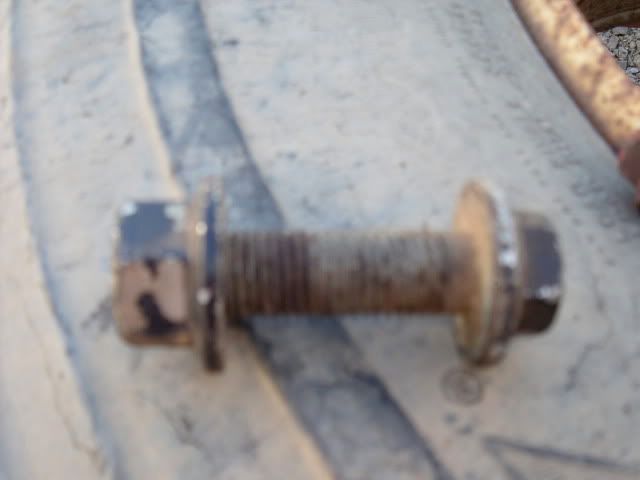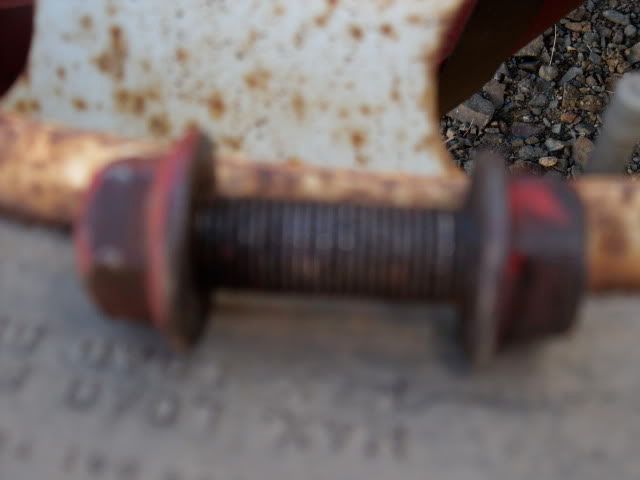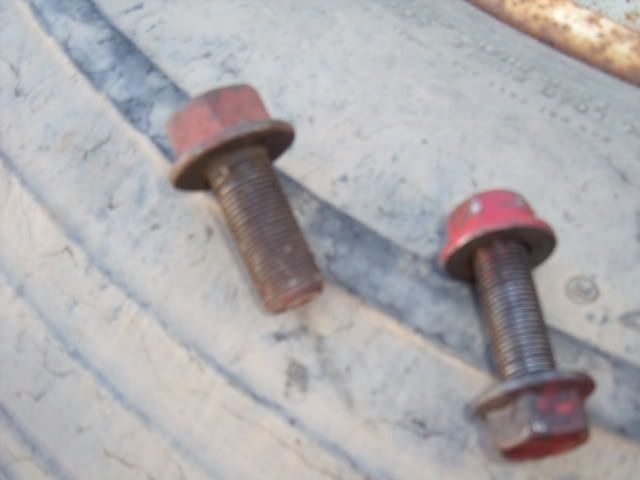- Posts: 2829
- Thank you received: 623
To Rivet, or not to Rivet
14 years 2 weeks ago - 14 years 2 weeks ago #26429
by
Replied by on topic Re: To Rivet, or not to Rivet
Swishy - You're showing your age! .. NF is a thread that was made obsolete in the 1930's by being replaced with UNF (Unified National Fine). BSF is a British thread, used on Pommy gear, and utterly obsolete. You can only find BSF fasteners and thread taps in places like eBay, or a few specialist suppliers, nowadays, and they're as rare as the proverbial.
Flat washers under the nut are a good idea, they spread the load under the nut.
Flat washers under the nut are a good idea, they spread the load under the nut.
Please Log in to join the conversation.
14 years 2 weeks ago #26430
by Sarge
Sarge
ACCO Owner, Atkinson dreamer.
Replied by Sarge on topic Re: To Rivet, or not to Rivet
you blokes give too much credit to Vicroads and their ilk.... any decision making as to standards is always done by an engineer, but in the case of swapping a rivet for a HT bolt who do you know is smart enough to realise a swap has been made.... and why would they be looking.
The roadworthy bloke is the only one who will see, if he bothers to look and he probably wont care,you could use blue tac and silastic and until it fell apart no one would know.
If it has been accident damaged and repaired it will have bolts.... of course us purists will never talk to you again because you use bolts!!!!!!!
/me
The roadworthy bloke is the only one who will see, if he bothers to look and he probably wont care,you could use blue tac and silastic and until it fell apart no one would know.
If it has been accident damaged and repaired it will have bolts.... of course us purists will never talk to you again because you use bolts!!!!!!!

/me
Sarge
ACCO Owner, Atkinson dreamer.
Please Log in to join the conversation.
14 years 2 weeks ago #26431
by
Replied by on topic Re: To Rivet, or not to Rivet
You are improving it by going to bolts!
Rivets aren't much better than cast iron in strength. Using grade 8 you have probably improved the strength by some where between 100 and 150% or more. Grade 5 probably be enough in this case as Grade 8 would probably be stronger than the castings and the frame!
Rivets aren't much better than cast iron in strength. Using grade 8 you have probably improved the strength by some where between 100 and 150% or more. Grade 5 probably be enough in this case as Grade 8 would probably be stronger than the castings and the frame!
Please Log in to join the conversation.
14 years 2 weeks ago #26432
by mammoth
Replied by mammoth on topic Re: To Rivet, or not to Rivet
I wouldn't try to rivet as the factory has all the gear to get the parts pressed up tight in jigs and then squash the rivet up just right. Along the lines of the Mack body bolts best engineering practice is to use fitted bolts. That is, drill undersize and then use a reamer to take the hole to a clean round (twist drills don't make truly round holes) fit requiring a light hammer to get the bolt in. Blackwoods is a good place to go to when you're getting through high tensile bolts by the box load. They also stock the high tensile washers which a lot of places don't.
Please Log in to join the conversation.
14 years 2 weeks ago #26433
by
Replied by on topic Re: To Rivet, or not to Rivet
If you were to rivet mammoth is correct lots of gear and is noisy and hot work! I have helped out many times riveting steam boilers. But you still have to drill, ream the holes and lightly hammer the hot rivets in! Just everything is hot and noisy! Stick to bolts!
Think of it this way nearly everything in the power train of a truck is bolted! The wheels, prop shafts, gearbox to engine, engine to frame and even the cylinder head! So why not the frame etc!
Think of it this way nearly everything in the power train of a truck is bolted! The wheels, prop shafts, gearbox to engine, engine to frame and even the cylinder head! So why not the frame etc!
Please Log in to join the conversation.
Less
More
- Posts: 295
- Thank you received: 0
14 years 2 weeks ago #26434
by JimmyDodge
Replied by JimmyDodge on topic Re: To Rivet, or not to Rivet
G' day Ron , thanks for the advice , you're an encyclopedia, Sarge, Jarrod , and Steve thanks for your input , I will sleep easy tonight! Problem sorted for me .
Thanks Guys , regards Harleigh.
Thanks Guys , regards Harleigh.
Please Log in to join the conversation.
14 years 2 weeks ago #26435
by
Replied by on topic Re: To Rivet, or not to Rivet
Guys
If using a grade 8 bolt with a nyloc it is a waste of a grade 8 bolt as the nyloc is the weak point.
If my memory is correct it brings it back to about a grade 5.
If it was me i would use a Grade 8 U.N.F bolt & nut fitted with a flat & spring washer and if you still want to have that added security add a bit of loctite.
Drilling & reaming the holes and using the correct bolt so the shank of the bolt is fitted tight in the hanger and frame is the way to go, if i can find a picture in one of my old engineering books i will post it.
Trevor
If using a grade 8 bolt with a nyloc it is a waste of a grade 8 bolt as the nyloc is the weak point.
If my memory is correct it brings it back to about a grade 5.
If it was me i would use a Grade 8 U.N.F bolt & nut fitted with a flat & spring washer and if you still want to have that added security add a bit of loctite.
Drilling & reaming the holes and using the correct bolt so the shank of the bolt is fitted tight in the hanger and frame is the way to go, if i can find a picture in one of my old engineering books i will post it.
Trevor
Please Log in to join the conversation.
14 years 2 weeks ago - 14 years 2 weeks ago #26436
by GM Diesel
GM Diesels - Converting diesel into noise since 1938.
Replied by GM Diesel on topic Re: To Rivet, or not to Rivet
At the risk of completely destroying all good engineering practice....and Im not intentionally trying to be a smart a$% but If this truck isnt go to see any load apart from your esky going to a show then you will be fine with a size drill and bolt...ie 5/8" UNF bolt and a 5/8" drill bit. Grade 8 bolt.
The youngs modulus and yield strength of these older chassis is way less than your bolts your going to use.
Onetrack and the others are dead right with reamed or fitted bolts for ultimate strength however your chassis wont be in this catagory being rivited from the start.
Some early Inters used a prostitute fit on chassis bolts and flanged heads on bolts and nuts. Transtar is a good example. All the chassis bolt holes are a 1/16" bigger than the bolts.
Dont make your resto any harder than it needs to be.....if its going to fail it'll be where youve been at it with the welder not where you havent ream fitted your bolts.
It is an interesting topic this one though. Should holes be punched or drilled ?....Autocar used to drill and ream all chassis holes quoting it was the only way to get a proper hole yet others punched holes in the press and didnt ream.
All comes down shear ratio of the joint in the end....
The VSB-6 National Code of Practice for heavy vehicle Modifications has some good reading on this topic.
Apologies in advance for any feathers ruffled
Basil
The youngs modulus and yield strength of these older chassis is way less than your bolts your going to use.
Onetrack and the others are dead right with reamed or fitted bolts for ultimate strength however your chassis wont be in this catagory being rivited from the start.
Some early Inters used a prostitute fit on chassis bolts and flanged heads on bolts and nuts. Transtar is a good example. All the chassis bolt holes are a 1/16" bigger than the bolts.
Dont make your resto any harder than it needs to be.....if its going to fail it'll be where youve been at it with the welder not where you havent ream fitted your bolts.
It is an interesting topic this one though. Should holes be punched or drilled ?....Autocar used to drill and ream all chassis holes quoting it was the only way to get a proper hole yet others punched holes in the press and didnt ream.
All comes down shear ratio of the joint in the end....
The VSB-6 National Code of Practice for heavy vehicle Modifications has some good reading on this topic.
Apologies in advance for any feathers ruffled
Basil
GM Diesels - Converting diesel into noise since 1938.
Last edit: 14 years 2 weeks ago by GM Diesel.
Please Log in to join the conversation.
14 years 2 weeks ago #26437
by
Replied by on topic Re: To Rivet, or not to Rivet
Bazza - It all comes back to how fussy you are, I guess. After rebuilding bulldozers and earthmoving equipment all my life, I guess I specialise in overkill .. 
The simple fact is that a spring perch takes a hammering. If the holes are bigger than the bolt shank, all you need is a slight relaxation of the bolt torque, and you've got a hole wallowed out. I've had too many wallowed out holes to deal with in my lifetime, so I prefer to make SURE they can't wallow out ..
Mammoth is obviously the mechanical engineer/fitter & turner amongst us. I would have mentioned reaming, but thought that was getting a little too fussy ..
A reamer is certainly the right tool for a perfect hole .. but has anyone ever miked a bolt shank?? Yep, they come off CNC machines, and forging presses at a rate that would make your eyes pop .. even Caterpillar bolts. The tolerance allowance on bolt shanks is nothing short of amazing, with 30 or 40 thou variation in concentricity and diameter being the norm. Thus, I didn't consider that reaming holes was critical.
Cheers, Ron ..

The simple fact is that a spring perch takes a hammering. If the holes are bigger than the bolt shank, all you need is a slight relaxation of the bolt torque, and you've got a hole wallowed out. I've had too many wallowed out holes to deal with in my lifetime, so I prefer to make SURE they can't wallow out ..

Mammoth is obviously the mechanical engineer/fitter & turner amongst us. I would have mentioned reaming, but thought that was getting a little too fussy ..

A reamer is certainly the right tool for a perfect hole .. but has anyone ever miked a bolt shank?? Yep, they come off CNC machines, and forging presses at a rate that would make your eyes pop .. even Caterpillar bolts. The tolerance allowance on bolt shanks is nothing short of amazing, with 30 or 40 thou variation in concentricity and diameter being the norm. Thus, I didn't consider that reaming holes was critical.
Cheers, Ron ..
Please Log in to join the conversation.
14 years 2 weeks ago #26438
by paul404
Replied by paul404 on topic Re: To Rivet, or not to Rivet
ive found the best chassis bolts to use are made by international trucks. they have a flanged head and nut. when you rattle them up it takes a very long bar to move them any more by hand. they are available in lots of sizes to suit chassis applications. apparently they are one of internationals biggest selling part.
the first picture is a factory fitted metric iveco bolt and nut. the others are unf. worth pricing them as they were reasonable when i was in the game. the best part is you dont need washers or loctite. where i found they came into their own is holding mudgaurd brackets to chassis. alot of times you see those brackets come loose when a high tensile bolt 2 high tensile flat washers and a nyloc nut has been used.
the first picture is a factory fitted metric iveco bolt and nut. the others are unf. worth pricing them as they were reasonable when i was in the game. the best part is you dont need washers or loctite. where i found they came into their own is holding mudgaurd brackets to chassis. alot of times you see those brackets come loose when a high tensile bolt 2 high tensile flat washers and a nyloc nut has been used.
Please Log in to join the conversation.
Time to create page: 0.495 seconds


